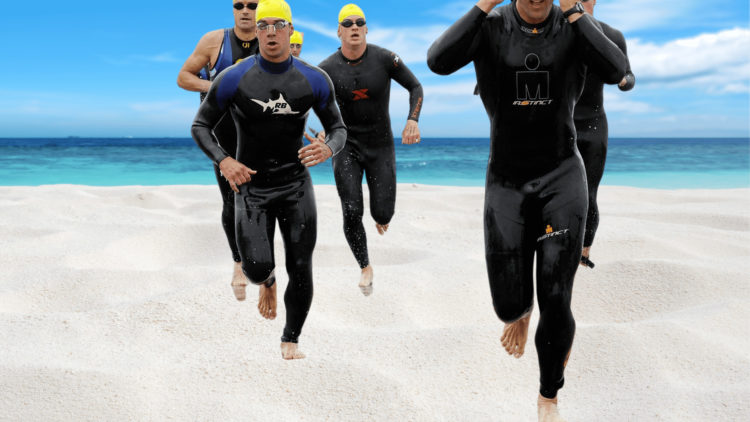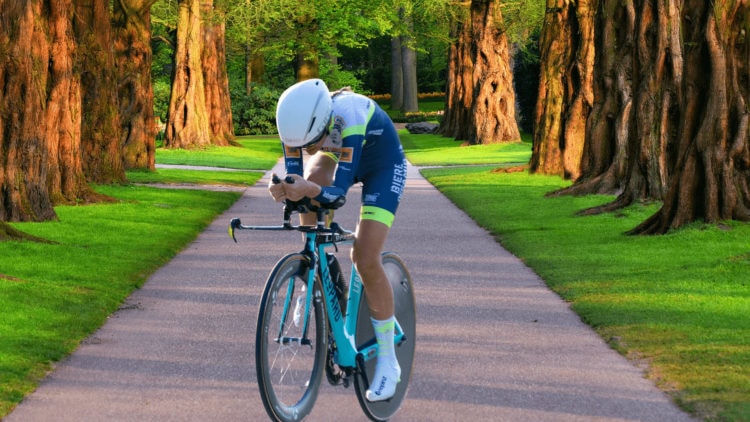
OBJECTIVE OF TRIATHLON: Complete the entire race, including swimming, cycling, and running portions, faster overall than the other competitors.
NUMBER OF PLAYERS: 3+ players
MATERIALS: Bicycle, wetsuit (cold water only), swim cap, bike helmet
TYPE OF GAME: Sport
AUDIENCE: 12+
OVERVIEW OF TRIATHLON

The first triathlon was in the 1920s in France. It is an endurance race that displays the versatility of the athletes competing. Training for an Olympic triathlon is rigorous as the competitors must swim .93 miles, cycle 25 miles, and run 6.2 miles in a single race. Olympic-level triathlons are the gold standard for triathlon competitions, and athletes will work up to these distances.
SETUP
Triathlons always start with the swim, then the cycle, and finally the run. In between each of the legs of the race, there are transitions that are still included in the competitor’s overall time.
Triathlon areas are set up so that when you finish one portion of the race, you can seamlessly continue to the next portion. So your cycling transition area will be very near where you finish the swim, and your running transition area will be very near where you complete the cycling.
Remember, every second counts in a triathlon, so you want your equipment set up so that it is as easy as possible for you to transition.
GAMEPLAY

Triathlons are a vastly popular competition, especially in Western Europe. All athletes will start the race simultaneously at a single start signal (usually gunfire or a buzzer). The first race is always the swim, the cycle, and then the run.
SWIMMING
An Olympic triathlon starts with a .93-mile (1.5 km) swim. The swim will either be across a body of water or a loop that takes you back to the same starting place. The route will be well marked with buoys and flags to prevent competitors from veering off track. There is not a certain stroke you must do, so you are free to swim however you would like. It is required to wear a wet suit in water that is below 60 degrees Fahrenheit.
CYCLING
The next portion of the triathlon is cycling. Olympic triathlons feature a 25-mile (40 km) bicycle race. After completing the swim, competitors will go straight to the cycling transition area, take off their wet suits, put on their cycling shoes and helmet, and go off. A good transition will only take around 1-3 minutes.
Cyclists must stick to the left side of the track to allow faster bikes to pass. It is also mandatory to wear a helmet during the cycling portion of the race.
DRAFTING
The most important rule for cycling in a triathlon is drafting. In the cycling portion of an Olympic triathlon, cyclists must leave a 32-foot (10 m) gap between the front wheels of each bicycle. Cyclists can pass through this zone for only 20 seconds to overtake other competitors. Riding in this zone for more than 20 seconds is illegal and will result in a penalty of up to 5 minutes.
RUNNING
The final portion of an Olympic triathlon is the run. Competitors will run 6.2 miles (10 km) for the final race in the competition. After finishing the cycling race, triathletes will move to the running transition area and quickly start running. Just as with cycling, runners must keep to the left to allow faster runners to pass. You are allowed to run as fast as you wish during the race and can even walk. All that matters is that you stick to the route and cross the finish line.
END OF GAME
Once your upper body crosses the finish line during the running portion of the race, you have completed the triathlon. Congratulations! Completing triathlons is not an easy feat! No doubt, countless hours of training go into each competition. The first athlete to cross the finish line is the winner. Although this is a competitive sport, many triathlon competitors focus more on their time and improving on it rather than the actual standings of the race.
- 30 GAMES TO PLAY OVER TEXT - April 22, 2024
- 20+ FREE PRINTABLE BABY SHOWER GAMES - April 16, 2024
- 20+ College Party Games for the Best Night Ever! - April 2, 2024